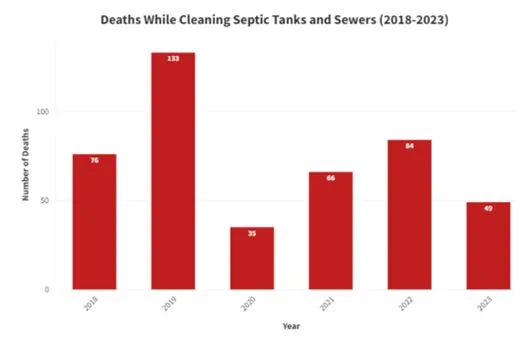

30th September 2024 (11 Topics)
Context
The Indian government has recently launched an ambitious initiative to profile and support sewer and septic tank workers (SSWs) across the country. This effort is part of the NAMASTE programme, which aims to mechanize sewer cleaning and prevent deaths associated with hazardous manual cleaning. Recent data reveals alarming statistics regarding the demographics of these workers, their conditions, and the need for systemic reforms in sanitation practices.
Key Findings
- Demographics of Workers: Over 38,000 workers have been profiled, with 9% belonging to Scheduled Castes (SC), Scheduled Tribes (ST), or Other Backward Classes (OBC). Specifically, 68.9% are SC, 14.7% are OBC, and 8.3% are ST.
- The profiling is conducted by the Ministry of Social Justice and Empowerment and focuses on various roles related to sewer cleaning, including drivers and helpers as part of its NAMASTE programme.
- Hazardous Conditions: Between 2019 and 2023, at least 377 workers died while performing hazardous cleaning tasks. The NAMASTE programme seeks to address these safety issues by providing training and better equipment.
- Current Status: The profiling has been completed in twelve states and Union Territories, while others are still ongoing. The government estimates there are approximately 100,000 SSWs across India.
- Economic Support: Since the program's inception, capital subsidies of Rs 2.26 crore have been disbursed to 191 beneficiaries for self-employment projects.
Causes of the Issue
- Historical Discrimination: Sanitation work in India is locked in with caste and carries social stigma. The majority of SSWs belong to marginalized communities highlights deep-rooted caste-based inequalities in access to better employment opportunities.
- Inadequate Mechanization: The lack of mechanized solutions for sewer cleaning has perpetuated hazardous working conditions, forcing workers to rely on manual methods that pose significant health risks.
Need to focus on SSWs
- The Union government’s rationale is that manual scavenging as a practice has ended across the country and what needs to be fixed now is the hazardous cleaning of sewers and septic tanks.
- It draws this distinction based on a technical difference in how manual scavenging and hazardous cleaning are defined in the Prohibition of Employment as Manual Scavengers and their Rehabilitation Act.
- The NAMASTE programme targets “workers directly associated with sewer and septic tank cleaning including drivers of desludging vehicles, helpers, machine operators and cleaners”.
- There are 100 core sanitation workers for an urban population of five lakh. As of 2021, there are likely to be one lakh SSWs employed by India’s 4,800 ULBs.
Fact box: About NAMASTE Scheme
Key-Legislations
|
More Articles



